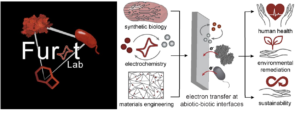Nanofabulous Seminar: Engineering biology for human and environmental health

For decades, researchers have worked to replicate the efficiency of biological processes for applications ranging from carbon sequestration to resource recovery. Yet engineered methods are generally less efficient and selective than their native counterparts . We have found that the integration of nano materials with microbial engineering enables us to create novel technologies that outperform conventional cleantech We have generated an inexpensive platform for rare earth element recovery, toxic pesticide remediation, and carcinogenic pollutant degradation.
We have also improved electrochemical conversion of CO 2 to valuable products, decreasing the energy required. Also, we have developed inexpensive, point of use diagnostics for infectious disease. In all of our work, we consistently find that the combination of chemistry and biomolecular engineering affords advantages beyond the capabilities of either technology alone.
Prof Ariel L. Furst
Chemical Engineering at MIT, USA.
11:00am, 18/12/2024
Melbourne Centre for Nanofabrication
151 Wellington Road, Clayton, 3168
Zoom link: click here
Meeting ID: 846 8564 5925 passcode: 622184
Click here for more information
Nanofabulous Seminar: Nanopores: From Biosensors to Cell-Instructive Interfaces
Our research bridges physics, materials science, and biology to explore living organisms down to the molecular level. Nanomaterials are central to our work. We have developed methods to fabricate and functionalize nanomaterials, tailoring them for biomedical applications. This includes designing sensors for localized detection of ions and biomolecules, and creating cell-instructive materials that can alter cellular functions for immunotherapy applications.
In this seminar, I will present our latest research on tailoring nanomaterials for biosensing and cellular engineering applications. We will explore the creation of nanopore sensors that operate near or even inside single cells, offering real-time insights into cellular functions and processes. Next, we will discuss how cells interact with nanomaterials and how nanotopographical constraints can alter immune cell functions and gene expression patterns. By using nanoporous surfaces, we have shown that these constraints induce biomechanical signals, leading to potent activation of T and B cells. The induced formation of cellular protrusions (microvilli) inside the nanopores significantly enhances cellular uptake through macropinocytosis. This provides a novel platform for gene or drug delivery to the cells, enabling manufacturing of genetically engineered cells (CAR-T cells) for potential applications in immunotherapy.
Prof Morteza Aramesh
Institute for Biomedical Engineering, ETH Zürich.
1:00pm, 4/12/2024
Melbourne Centre for Nanofabrication
151 Wellington Road, Clayton, 3168
Zoom link: click here
Meeting ID: 856 9549 7894 passcode: 574455


